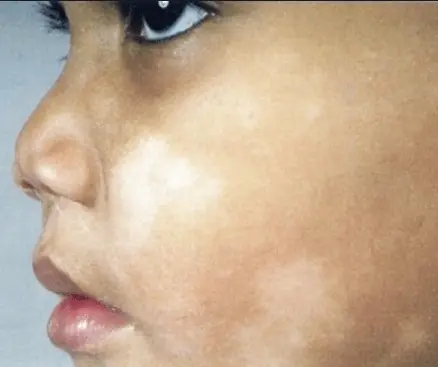White Patches In Children
can be challenging. White patches can have various causes, ranging from simple to more complex conditions. Accurate diagnosis by dermatologists is crucial to prevent potential complications.

Key Highlights: Causes of white patches could be:
- Nutritional deficiency
- Fungal or bacterial infections
- Autoimmune disorders
- Pityriasis alba
White Patches In Children at a Glance
- Best Results: Pityriasis Alba, Sun Rash
- Treatment Duration: 2 to 6 Months
- Result Longevity: Permanent in Most Cases
- Return to Daily Activities: Immediate
- Recovery Time: None
- Blood Tests: Required
- Performed By: Dermatologist
- Cost: ₹ (Consultation required)
Our results speak for themselves






Our pediatric dermatologists specialize in uncovering the causes of white patches in children by thorough examination and detailed medical history.
Diet and Vitiligo
- Vitiligo: Typically starts with small, isolated patches that may expand and merge. Skin appears smooth, shiny, and completely white.
- Other White Patches: May appear as dry, scaly, or itchy patches. Skin may not be completely white, and patches may be smaller and more scattered.
Consult a Pediatric Dermatologist:
If you notice white spots or patches on your child’s skin, consult a pediatric dermatologist for an accurate diagnosis and treatment plan. They will assess your child’s skin and provide guidance on managing the condition.
Early diagnosis and treatment can make a significant difference in managing vitiligo and other skin conditions. Book your appointment for pediatric dermatology consultation in Chennai to find solutions now.
Frequently Asked Questions
White spots on children’s skin can be concerning.
- Vitiligo is a skin pigmentation disorder characterized by white patches due to loss of melanin-producing cells. Vitiligo can start at any age, including childhood.
- Other White Patches: Caused by conditions like pityriasis alba, eczema, or fungal infections. These patches are often temporary and may not be related to vitiligo.
Be aware of these photosensitivity skin conditions:
- Sunburn: Redness, pain, and blistering caused by UV radiation.
- Polymorphic light eruption: A sun skin allergy rash triggered by UV exposure.
- Solar urticaria: Hives caused by UV radiation.
For sunburn allergy relief, consult your pediatrician or pediatric dermatologist for personalized advice.
When selecting sunscreen for kids, consider:
- Broad-spectrum protection: Choose sunscreens with SPF 30 or higher that protect against UVA and UVB rays.
- Physical sunscreens: Opt for physical sunscreens containing zinc oxide or titanium dioxide, which are gentler on children's skin.
- Water-resistance: Select water-resistant sunscreens for kids who swim or sweat heavily.
- Hypoallergenic and fragrance-free: Choose sunscreens that are hypoallergenic and fragrance-free to minimize skin irritation.
In addition to sunscreen, practice these sun protection safety habits for children:
- Dress for success: Dress kids in protective clothing, including wide-brimmed hats and long-sleeved shirts.
- Seek shade: Whenever possible, seek shade, especially during peak sun hours (10 am–4 pm).
Wear sunglasses: Encourage kids to wear sunglasses with UV protection.
Pityriasis alba (PA) is a common, harmless skin condition that causes small, round, white patches on the face, neck, and arms. It's most often seen in children and adolescents, especially those with a history of eczema or allergies. The patches are usually dry and scaly and may itch slightly. PA is not contagious and typically resolves on its own within a few months.

